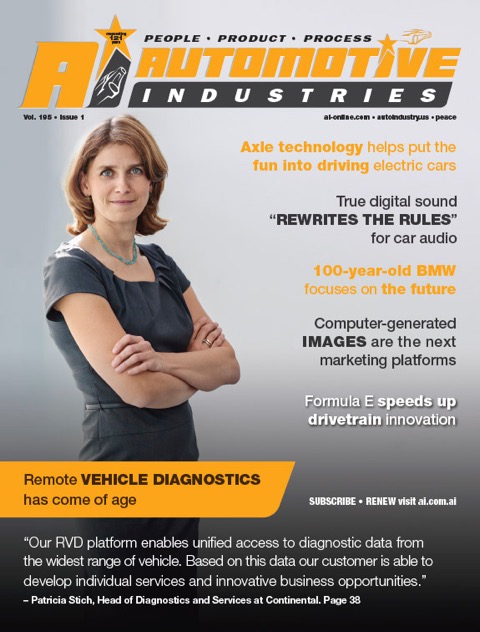
Being able to monitor and analyze the state of a vehicle remotely and in real time allows manufacturers and their workshops to differentiate themselves in the market place by offering innovative and personalized services. It is possible to check out the current state of a vehicle remotely, analyze this information and make use of it to develop innovative services. One of the leaders in the field of connecting vehicles to industry systems is Continental, which has developed the Remote Vehicle Diagnostics platform (RVD).
Automotive Industries (AI) asked Patricia Stich, Head of Diagnostics and Services at Continental, what benefits Remote Vehicle Diagnostics offers the automotive industry in particular.
Stich: Manufacturers have a great need to learn more about the condition of “their” cars. If the OEMs can stay in touch with the cars throughout their entire life cycle they can get new ideas on how to improve their quality assurance and customer service. Remote Vehicle Diagnostics (RVD) makes this possible.
AI: In what ways is this changing customer service?
Stich: With RVD the whole process can be organized much more efficiently. Workshops know about the state of the vehicle at all times. They therefore have the information needed to offer attractive and individually tailored services to their customers. Customers feel that “their” workshop is giving them personal attention. Moreover, service centers can optimize their capacity and slim down their processes. For example, they can order necessary spare parts before the vehicle is brought in and optimize their maintenance schedules. This provides benefits for everyone involved. Workshops can automate their processes and cut costs. Drivers can avoid long waiting times and possibly even save on repairs because servicing is carried out at the right time.
AI: Are there other segments that will profit from RVD?
Stich: Yes. For example, vehicle fleets can be managed more efficiently with our platform. Remote access to diagnostic data gives fleet managers a clear picture of the state of their cars and the productivity of the fleet. Proactive maintenance can reduce downtime, optimize processes at the service desk and increase the utilization of vehicle capacity. Our platform can also be used in entirely different sectors – basically, by any service provider that needs current vehicle data for its applications.
AI: What distinguishes Continental’s RVD solution from those of other companies?
Stich: Our platform enables unified access to diagnostic data from the widest possible range of vehicles. It converts different cryptic error codes into readily understood information. Our RVD platform can also be integrated without difficulty into a customer’s service environment, permitting the addition of valuable diagnostic data to existing services. The solution is rounded off by the Continental SDK, which makes it possible to develop mobile device services quickly and easily.
There are several hardware options for transmission, including a Bluetooth dongle for getting started quickly and a GSM-based solution that transfers the data directly. Manufacturers can use our retrofit solutions to offer additional services via their existing vehicles. In addition they can develop embedded solutions for new vehicles, for example incorporating an onboard unit. AI: A number of dongle solutions already exist. What makes yours different?
Stich: You’re right. Dongles are available from many vendors. But the decisive factor is the quality and the volume of the diagnostic data. Most of the current solutions only cover standard data, and they try to compensate for a lack of information on specific models. Depending on the application, this can result in significant inaccuracies and wrong conclusions. Our solution can access manufacturer-specific data like mileage, fuel level and the condition of the brake linings. This not only improves the quality of the data, it also allows many more applications to be realized.
AI: How important are safety issues for the success of innovative diagnostic solutions?
Stich: Safety and security naturally play a very important role in such a sensitive field as vehicle diagnostics. For example, we only download safety-relevant data when the car is in a safe condition, such as when it stops at traffic lights.
AI: What is the future of diagnostics from your point of view?
Stich: The future is already here, and there are tremendous opportunities for many market players! Our RVD platform is revolutionizing diagnostics, and it opens up opportunities in areas such as preventive maintenance and core remote functions like over-the-air updates and easy electronic control unit flashing



More Stories
Accelerating The Development of Hydrogen Vehicles & Infrastructure – Europe’s Biggest Players Meeting at Premier Event
Automotive IQ Announces the 15th Annual Automotive Functional Safety Week 2025
Major Automotive Companies to Share Latest Developments in Steering, Braking, Chassis and Suspension Systems at Premier Industry Event